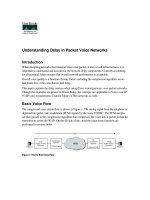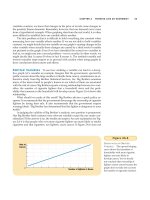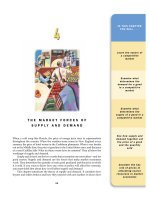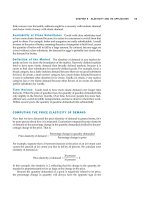Tài liệu Leadership & success In economics, law, & technology ppt
Bạn đang xem bản rút gọn của tài liệu. Xem và tải ngay bản đầy đủ của tài liệu tại đây (978.65 KB, 173 trang )
L
EADERSHIP &
S
UCCESS
In Economics, Law, & Technology
Society or external interactions
Marcus O. Durham, PhD
Robert A. Durham, PhD
Rosemary Durham
Dream Point Publishers
Tulsa
2
Leadership & Success
In Economics, Law & Technology
Society or external influences
Contact:
THEWAY Corp.
P.O. Box 33124
Tulsa, OK 74153
www.ThewayCorp.com
Cover Design: Rosemary & Marcus O. Durham
Cover photo: “Epitome of Society”, US Capitol in Washington, DC
taken by Rosemary Durham
Printed in United States of America
First printing by Fidlar Doubleday, January 2005
Second printing by Fidlar Doubleday, January 2006
Library of Congress Control Number
ISBN: 978-0-9719324-7-6
Copyright © 2005-2006 by Marcus O. Durham
All rights reserved under International Copyright Law. Contents and/or
cover may not be reproduced in whole or in part in any form without the
express written consent of the Publisher.
3
4
5
TO
Pettie Beason Durham, my Mom, who taught me by getting things
done while others were thinking about it.
In Memoriam:
William O. Durham, D. Min., my Dad, who taught me about
leadership through example, before I knew its importance. During
his youth, because of the Great Depression, he only went through
the eighth grade. At age 79, he completed his Doctorate.
⇐
⇑ ⇒
6
TABLE OF CONTENTS
Title Page .......................................................................... 1
Leadership & success series.......................................... 12
Where we are going 11
1. Quality.....................................................................................13
Excellence 13
Quality vs quantity demand 14
History 15
General MacArthur 16
W. Edwards Deming 17
J C Penney 18
Other quality gurus 20
What is good enough 20
Tools 22
Charts 23
Brainstorming 24
Positive-negative lists 26
Benchmarking 27
Flowchart 27
ISO 9000 standards 28
Review 29
2. Iso 9000....................................................................................32
Certification process 32
Quality Manual 34
Review 53
3. Law and Government.............................................................54
Tradition 54
Equity and law 58
US government system 60
Federal court system 63
State court system 64
Review 64
Leadership & Success Series 7
4. Litigation .................................................................................66
Disagreement 66
Before litigation 66
Litigation 67
Trial 70
Evidence 72
Legal liability 72
Review 76
5. Contracts .................................................................................77
Agreement 77
Elements 78
Standard contract items 79
Professional compensation 79
Contractor compensation 80
Contractor relationships 81
Review 83
6. Employment law .....................................................................84
What is the basis 84
Major federal laws 85
Title VII 86
ADEA 87
ADA 87
FMLA 88
FLSA 88
EPA 89
At will exceptions, one state 90
Judicial public policy exception 91
Judicial implied contract exception 92
Judicial covenant of good faith 93
Review 94
7. Project management...............................................................96
What skills 96
Most Successful PM 98
Fourteen principles 99
Review 108
8. Project schedule and cost.....................................................110
Tools 110
Work breakdown structure 111
Detailed WBS 112
Gantt 115
Network scheduling methods 117
8 Leadership & Success in Economics & Society Durham
Elapsed time 118
Activity on arrow 119
Activity on node 122
Probable time estimates 124
Cost estimates 125
Project budget 126
Cost control 127
Review 128
9. Time value of money ............................................................ 130
Economics 130
Time and interest 131
Uniform series 132
Gradient 134
Nominal interest or APR 135
Perpetual and rule of 72 136
Rate of return 136
Incremental analysis 137
Payback 138
Benefit cost ratio 139
Tax implications 139
Table of terminology 139
Commentary 140
Review 141
10. Oops, When things go wrong! .............................................144
What happens 144
Leadership issues 145
Projects trade-off 146
Skills 147
How to tell 148
Leadership decisions 148
Leadership & Project Evaluation Process 150
Risk management 151
Stop loss 151
Gather data 152
Putting out fires 154
Origin 154
Cause 155
Analysis 156
External 157
Opinion 158
Responsibility 159
Non-technical 160
Leadership & Success Series 9
Review 160
11. Review via aphorisms...........................................................162
A pithy saying 162
Principles 163
Leadership & Project Evaluation Process 164
End 166
12. About the authors.................................................................167
Personal - MOD 167
Marcus O. Durham 169
Robert A. Durham 170
Rosemary Durham 171
Cover 172
⇐
⇑ ⇒
10
PREFACE
Everything we know is developed from something we have read,
heard, or seen. Therefore, these other thoughts necessarily influence
what we write. To the best of our knowledge, we have given
specific credit where appropriate.
Rather than footnotes or references, we have listed the works that
have provided significant information in one way or another, since
this is often in concepts rather than quotes.
Statements that are attributed to us are things we have used
commonly and do not recall seeing from someone else. Others
obviously have similar thoughts. If we have made an oversight in
any credits, we apologize and we would appreciate your comments.
⇐
⇑ ⇒
11
LEADERSHIP & SUCCESS SERIES
Thought
People are where they are
because of the choices they make
MOD
Where we are going ______________
How vast is the topic of Leadership and Success? How can you
benefit from skills in leadership? Can there be success without
leadership in some area? Are the principles the same for an
individual, a group, or a society? Are the practices the same for an
individual, a group, or a society? Is this a topic that can be taught or
is it something that is innate? How do you define leadership? What
is success?
These are just some of the questions answered in the series on
Leadership and Success. The topic is too broad for a single book. A
series of three volumes provide the foundations for continued
personal development and growth.
Each book in the Leadership & Success series addresses a different
group of topics, each related to your success as a leader. The
structure of this series is based on the three areas of leadership
involvement: internal development, horizontal interactions, and
vertical relationships. The progression of the three books is arranged
in the order in which you, as a leader, can have the most impact:
people, organization, and society.
The first book, on relationships and communication, deals with
individual relationships and how others perceive you. These
chapters are primarily involved with areas that you can impact
12 Leadership & Success in Economics & Society Durham
directly. Relationships and communication is most interesting and
intriguing. Think about it. Everything we do is defined by how we
interact with others, while the topic of communication includes
everything from individuals to presentations and visual cues.
The second book, on organizations, culture, and ethics, deals with
the makeup of a venture or association. These chapters are primarily
oriented toward optimizing the performance within a group that may
be global. Think about it. Our culture is defined by how we interact
with others, while the topic of organizations includes everything
from businesses to social groups and even families.
The final book, on economics, law, and technology, concentrates on
the influences of society and groups outside your sphere. Society
includes everything that is outside of an organization. Economics
impacts the amount of money in your bank account. This book has
practical, day-to-day keys that you can use to make your venture
successful.
How is the best way to use the series? Because each is a stand alone
work, they can be used individually or as a group. The method
depends on the forum and the needs.
The books are structured for seminars as well as personal study. The
chapters are configured for a one to one-and-a-half hour discussion.
By completing all the activities, most chapters can require three to
four hours. Although the combination of books makes an excellent
text for a technical and engineering management course or
executive development programs, they are beneficial to anyone
desiring to improve.
These topics will be approached from the context of communication
and relationships, and will follow closely the principles developed
in the first book in the series. The remainder of the books will
discuss components of leadership and management, and will include
people relationships, organizations, and the tools necessary for
success. The topics, then, will include both the application and
implementation elements of a successful leader or a manager.
⇐
⇑ ⇒
13
1
QUALITY
Thought
The marketplace does not tolerate dishonesty.
An inferior company in any area will be driven out.
MOD
Excellence ______________________
What is quality? Is it better for the organization or the customer?
Who is responsible for quality? Is there a cost associated with
improved quality? When is good enough, okay? Does everyone
want quality?
Quality involves technical, economic, and legal issues. It is a
component of risk management, which includes safety,
environmental, and quality. Project management can be described as
the trade-off between time, money, and quality. It is very obvious
that quality is a major factor in every organization
Various names are used to describe the practice of pursuing quality.
It may be called total quality management (TQM), quality control,
quality assurance, continuous improvement or variations of these
names.
Quality is excellence.
- MOD
14 Leadership & Success in Economics & Society Durham
Dr. Bruce Ewing has an admonition that reflects quality. [Ewing] It
is the very definition of being exceptional.
Step out and be different.
- Dr. Bruce Ewing
Quality is the decision to obtain excellence. Quality is simply doing
what you say you are doing. That is the same definition that was
used earlier for integrity.
Quality is integrity.
Notice the relationship.
Quality is the major part of equality.
Quality vs quantity demand _______
Project management has been described as the tradeoff between
time, money, and quality.
How does that correlate with the concept where quality is
excellence? Lesser quality can be obtained for less money. In some
instances, there is a conscious decision to spend less money, and
therefore to accept an item of reduced quality.
Dr. Paul Zane Pilzer in Unlimited Wealth discusses the relationship
between quantity demand and quality demand. He argues that there
is an insatiable appetite from customers. First customers want a
quantity of items. Then after obtaining some number, the customer
then begins requiring improved quality.
His theory has been demonstrated in this country with the
introduction of new products, which are often little more than Beta
test versions. After consumers have one of the product, they begin
to want higher performance. It has also been observed in developing
countries. First people just want anything. Then as that market
begins to develop, they are willing to import higher quality.
Chapter 1 Quality 15
The development of technology drives quality demand.
History _________________________
Much of the technology advances that affect our daily lives have
been precipitated since World War II. That conflict caused several
changes in the world scene.
First, it brought countries around the world into an alliance. For
example, Japan and the United States did not have a particularly
good relationship previously; now those two countries are allies on
many fronts. Second, it created superpowers that had the money and
resources to pursue technology. The space race was impetus for
much of today’s electronics and health development. Third, nations
that had previously been focused on less than economic
development had a chance to start their economies from scratch.
Notably, Japan and Germany were destroyed and rebuilt with new
technology under the direction of United States financing and
technology support.
These new societies first were subservient, then became partners,
and eventually entered into friendly competition. Bowles and
Hammond in Beyond Quality describe the events. [Bowles] From
1950 to 1980 the United States share of the worldwide automobile
market declined from 76% to less than 21%. Of the radios that were
sold in the United States from 1955 to 1975, the percentage that
were manufactured domestically declined from 96% to near 0%. In
the 1980’s, the United States share of the worldwide semiconductor
market declined from 60% to 40%
Part of the picture comes from the quality of the product. Joseph R.
Jablonski in Implementing TQM gives statistics about the state of
manufacturing. [Jablonski] Eighty percent of the automobiles from a
Ford line went immediately to a rework facility in 1974. How much
did that cost? In 1978 Ford Motor Company sold steel from its mills
to European countries, while purchasing steel for its automobiles
from Japan. Eventually, it closed its mill.
16 Leadership & Success in Economics & Society Durham
Hewlett-Packard, a long time electronics consortium purchased
memory chips in 1980. Initial tests had a failure rate of 11 to 19
failures per thousand for US manufacturers and 0 for Japanese
manufacturers. Infantile tests after the first 100 hours of use had
similar comparative failure rates. The US chips failed at a rate of 27
per thousand while those manufactured in Japan had less than 2
failures per thousand. During that period, Japanese quality was more
than an order of magnitude better.
The marketplace does not tolerate dishonesty. A company inferior
in any area will be driven out.
General MacArthur ______________
How were the ‘new kids’ able to compete so quickly? Interestingly,
General Douglas MacArthur is the answer. At the end of World War
II, he was given the responsibility of administering Japan’s
redevelopment. He brought in Dr. W. Edwards Deming, a physicist
and statistician with the US Department of Agriculture.
Deming had a reputation within a rather limited field in the US.
However, he quickly became the guru for the Japanese economy’s
development. He developed the idea of continuous improvement
and placed responsibility on the managers with the workers as part
of a team. His philosophy is what became so admired about
Japanese companies. What an opportunity to prove your worth by
developing the economy of an entire nation.
Dr. Deming was still virtually ignored until he was 80 years old. In
1980, an NBC News White Paper television documentary “If Japan
Can … Why Can’t We?” made him the recognized guru of quality.
[NBC]
Survival is optional
- Dr. W. Edwards Deming
Chapter 1 Quality 17
W. Edwards Deming ______________
Dr. Deming in Out of Crisis described 14 points for transformation
of management and transformation of American industry. These
principles apply to any organization or individual that is in the
pursuit of excellence. We added the italics as a memory aid.
1. Create constancy of purpose toward improvement of product
and service, with the aim to become competitive and to stay in
business and to provide jobs.
2. Adopt the new philosophy. We are in a new economic age.
Western management must awaken to the challenge, must learn
their responsibilities, and take on leadership for change.
3. Cease the dependence on inspection to achieve quality.
Eliminate the need for inspection on a mass basis by building
quality into the product in the first plaice.
4. End the business of awarding business on the basis of price tag.
Instead, minimize total cost. Move toward a single supplier for
any one item, on a long-term relationship of loyalty and trust.
5. Improve constantly and forever the system of production and
service, to improve quality and productivity, and thus constantly
decrease costs.
6. Institute training on the job.
7. Institute leadership. The aim of supervision should be to help
people and machines and gadgets to do a better job. Supervision
of management is in need of overhaul, as well as supervision of
production workers.
8. Drive out fear so that everyone may work effectively for the
company.
9. Break down barriers between departments. People in research,
design, sales and production must work as a team, to foresee
18 Leadership & Success in Economics & Society Durham
problems of production and in use that may be encountered with
the product or service.
10. Eliminate slogans, exhortations and targets for the work force
asking for zero defects and new levels of productivity. Such
exhortations only create adversarial relationships, as the bulk of
the causes of low quality and low productivity belong to the
system and thus lie beyond the power of the work force.
11. Eliminate work standards (quotas) in the work place. Substitute
leadership. Eliminate management by objectives. Eliminate
management by numbers, numerical goals. Substitute
leadership.
12. Remove barriers that rob the workers of their right to pride of
workmanship. The responsibility of supervisors must be
changed from sheer numbers to quality. Remove barriers that
rob people in management and in other departments of their
right to pride of workmanship. This means abolishing the
annual or merit rating and management by objective.
13. Institute a vigorous program of education and self-improvement
for everyone.
14. Put everybody in the company to work to accomplish the
transformation. The transformation is everybody's job.
J C Penney ______________________
J. C. Penney was an early American entrepreneur. [Penney] He
began a chain of department stores that has survived over 100 years.
He opened his first store in Kemmerer, Wyoming in 1902. He
delivered an address to his new employees about 1902. It is an
excellent, concise model of pursuit of quality.
My Newly Acquired Associates:
My talk to you this evening is to be very brief and very much to the
point. The name of our store is "The Golden Rule Stores." The
policy upon which we expect to build is just what the name implies.
Chapter 1 Quality 19
Do unto others as you would have them do unto you. I think I need
say no more, because in those few words, I have said much. If a
business can be built on the principles of the Golden Rule, and I
firmly believe it can, we shall go forward and some day we shall
add to this one unit another store and another store, and some day
we might have as many as ten stores. Right here I want to
emphasize this: treat our customers all alike and treat them as we
would like to be treated as a customer. We will sell for cash only,
thereby avoiding losses through credit; we will have no delivery
system, so we can pass this saving on to our customers. We will
have no expensive fixtures for which we would have to go in debt;
we will pay cash for all our merchandise so we can take advantage
of all discounts and not have to pay interest. We will buy only good
merchandise to sell to our customers. Because of all the advantages
that will be ours, we will sell for less and never will we sacrifice
quality for an unreasonably low price.
This is my brief story in a simple and plain language. Now as you
go forward tomorrow serving our customers, and the opportunity
presents itself, tell them what I have said and tell them in such a
way that they will understand we have opened a new kind of store,
planned and designed to render service unprecedented in the history
of merchandising. Solicit their continued patronage on the Golden
Rule Motto.
"The Penney Idea" is a declaration of ethics and purpose that
Penney wrote in 1905 and was adopted by the J.C. Penney
Company in 1913. The seven principles continue to guide the
company today.
1. To serve the public, as nearly as we can, to its complete
satisfaction.
2. To expect for the service we render a fair remuneration and not
all the profit the traffic will bear.
3. To do all in our power to pack the customer's dollar full of
value, quality, and satisfaction.
4. To continue to train ourselves and our associates so that the
service we give will be more and more intelligently performed.
5. To improve constantly the human factor in our business.
6. To reward men and women in our organization through
participation in what the business produces.
20 Leadership & Success in Economics & Society Durham
7. To test our every policy, method, and act in this wise: "Does it
square with what is right and just?"
Other quality gurus_______________
Joseph M. Juran wrote the Quality Control Handbook in 1951. It has
numerous updated editions. [Juran] Juran was with Western Electric
a subsidiary of AT&T, the communications giant. He followed
Deming to Japan in 1956. Juran’s contribution to the Japanese
economic machine was transferring focus from technology to
concern for the overall product management.
Armand V. Feigenbaum wrote Total Quality Control. [Feigenbaum]
He was with General Electric, the electrical manufacturing giant. He
coined the term total quality control.
Philip B. Crosby was with ITT and the Martin Corporation. In 1962,
he delivered the Pershing missile system on time and with no
defects. [Crosby] “Zero defects” has become the standard objective
for many organizations.
Motorola Corporation, not an individual, initiated the 6-sigma
program. The objective is to develop a manufacturing process that
produces products with defects six standard deviations to the right
of mean, or 10 parts per million. The industry standard is about
three sigma, or 3 parts per thousand. Motorola is well toward the
standard and has seen millions of dollars of savings.
What is good enough______________
If it ain’t broke, don’t fix it.
- popular adage.
Contrast that with Dr. Deming’s philosophy.
Improve constantly and forever the system of production and
service.
- Dr. W. Edwards Deming
Chapter 1 Quality 21
There is a tension about quality. What is good enough? Is 99%
performance acceptable? That will get a student an A in any class.
At 99% we would
• Have unsafe drinking water only 3 or 4 days a year.
• Have electricity outages only 15 minutes per day.
• Have all telephone service out 5 minutes per day.
• Have computers and other electronics shutdown 15 minutes per
day.
• Have only 100 airlines that did not reach their destination each
day.
Consider six-sigma. Assume there are 1 million cars driving in a
city. That implies there will be 10 accidents.
Is that adequate? No! Society has moved to where perfection is
expected. Anything less is an irritant that is not tolerated.
From these discussions, we find there are four fundamentals to total
quality management.
1. Continuous improvement in the process
2. Focus on the customer
3. Teams are crucial.
4. Management provides leadership, support, and active
involvement.
It is not a complex process. It does not require a large number of
calculations. It is a desirable process. It does require commitment
from the team and management.
The objective of a quality program is to grant every person in the
organization responsibility and authority for quality. Management
provides the support to make it happen.
-MOD
The model of quality is a bottom up structure. It is the antithesis of
most organizations. The economic benefit to the organization more
22 Leadership & Success in Economics & Society Durham
than pays for any incremental cost associated with continuous
improvement in quality.
This philosophy of consistent performance has prompted the
development of international standards. The purpose of standards is
not to tell in detail what to do, but to assure consistent results. If
something goes awry, there is a process to handle it. The
development and implementation of standards will be addressed in
the next chapter.
Tools __________________________
Traditionally, quality has been addressed from the perspective of
statistics and probability. That is great for an engineer or
mathematician, but is less comprehensible to the tradesman or the
people that are less technically trained. It is not necessary to use
those techniques to track quality.
Data is available in every organization that reflects the quality of the
process. Since the newer standards are more focused on following a
process and customer satisfaction, there is less necessity for
mathematical analysis. Nevertheless, charts are very beneficial to
describe events tied to quality improvement. Charts illustrate trends
much clearer than words or numbers.
Dr. Deming discussed two types of causes for deviation from the
desired. These are special and common causes. Special causes are
fleeting events that are controllable. Examples are operator error or
a machine out of adjustment. These are correctable by a single
person.
Common causes are inherent in the system and are uncontrollable
by an individual employee. These are things such as wear, or the
process being out of control.
Even when a process is in control, there are some variations about a
reference value. To determine if a process is in control only three
terms are needed, the reference value, the upper limit tolerance, and
Chapter 1 Quality 23
the lower limit tolerance. These limits are typically three-sigma,
which represents three parts per thousand. A closer tolerance
objective is six-sigma, which is a maximum of 10 parts per million.
As it turns out there are only a very few control measurements that
are used for reference values. The table lists all possible variations,
broken into two sections. Variables include measurements such as
size. Attributes are a ratio of defects per items.
Variables Attributes
x
Mean
p
Proportion defective / batch
R
Range
np
Number defective / batch
s
Standard deviation
c
Number of defects / batch
M
Median
u
Number of defects / unit
Charts __________________________
Control charts are made with one of these items as the reference
value. A nominal value for the reference is ascertained, and the
upper and lower limits are calculated. The data are plotted as the
reference value. If the values stay inside the limits, the process is in
control. Typically only one or two reference variables are used for a
particular process evaluation.
A process can go out of control in one of two ways. The mean can
begin deviating out of control in one direction. This will happen
with gradual wear on a part. The other is for the swing to be out of
limits in both directions.
After establishing a mean, upper limit, and lower limit for data, it is
unnecessary to monitor every item. Samples can be made from the
production. It is important that the samples be taken in some regular
fashion, such as every X minutes, or every Y parts. The tolerance
for each of these samples is plotted on a trend. The direction of the
data can be extrapolated to apply to all the components from that
same production run.
24 Leadership & Success in Economics & Society Durham
Once the data is gathered, the type of chart used to display the data
tends to be at the preference of the creator. In a spreadsheet, the type
of chart used can be changed with only a couple of clicks.
A histogram is a bar graph of a frequency distribution. The widths
of the bars are proportional to the classes into which the variable has
been divided. The heights of the bars are proportional to the
frequency of the class.
A Pareto chart is a bar chart in which the bars are arranged in a
descending order of their occurrence or length. This is similar to a
histogram. Its major benefit is illustrating the things that impact the
project the most.
A run chart is a timeline. It is a line graph that shows data points
plotted in the order in which they occur. They are used to show
trends and shifts in a process over time, variation over time, or to
identify decline or improvement in a process over time. They can be
used to examine both variables and attribute data.
A scatter diagram is also called an XY chart. It is used to interpret
data by graphically displaying the relationship between two
variables.
Brainstorming __________________
Many non-numeric practices are used to develop a plan and to
compare alternatives.
Practices are many, principles are few.
Practices may change, principles never do.
Four techniques are commonly used, brainstorming, flowcharting,
positive-negative lists, and benchmarking.
Brainstorming or dream sessions are used by many groups in a
variety of situations. The basic approach dates back at least to
Chapter 1 Quality 25
Benjamin Franklin and his Junto. [Junto] The details of Franklin’s
organizations were described in the second book [Durham].
Brainstorming is an excellent way to develop creative solutions to a
problem. The process is to focus on a problem, or opportunity, and
come up with very many radical solutions or potential actions.
An individual can brainstorm on his own. He will tend to produce a
wider range of ideas than a group session. He does not have to
worry about other’s egos or opinions. However, he will not be as
effective, since he does not have the group experience.
A group brainstorming session must be operated with a few
guidelines. The list is compiled from a variety of sources. It may
vary some from other lists, but it is effective.
1. Define the problem to be solved clearly.
2. The session should be focused on only one problem at a time.
3. No one may criticize or offer an evaluation of an idea. If they
do, they are penalized. Ben Franklin invoked a small pecuniary
penalty for infractions of direct contradiction, one upmanship,
and negative attitude.
4. Attempt to get everyone to contribute and develop ideas;
however, do not force responses from individuals.
5. Welcome creativity. Have fun. Ideas may range from practical
to wild.
6. Keep the train of thought moving.
7. Encourage piggyback, developing ideas from others.
8. One person notes the ideas of everyone on a visual display.









